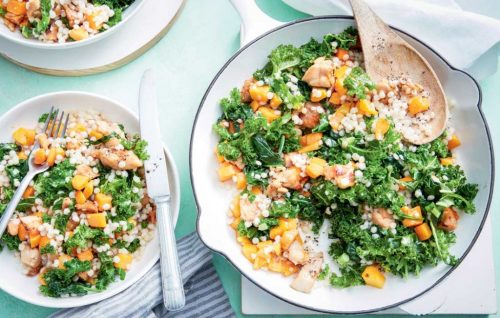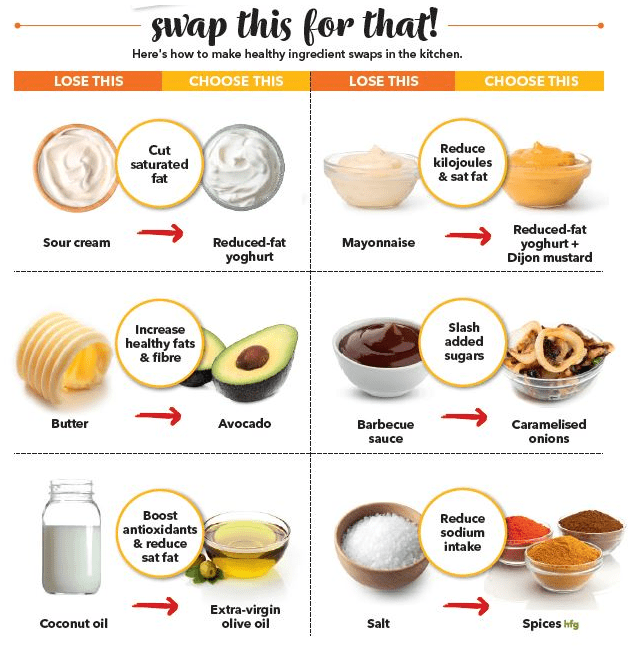
Are you new to cooking? Or just need some healthy eating inspiration? Let HFG take you back to basics…
Healthy eating doesn’t have to be boring — and it never is! In fact, it’s easy to cook meals that are healthy and delicious. Don your apron!
Start with the basics
The first step to any healthy meal is getting the balance right. Every meal needs lean protein, quality carbohydrates and a variety of colourful vegetables. Having these key components in the right proportions is equally as important! Aim to fill up one-quarter of your plate with protein, another quarter with carbohydrates and the remaining half with a vibrant mix of vegetables.
¼ Protein power
A protein-rich diet has been scientifically proven to help you maintain a healthy weight.
Protein doesn’t just come from meats like beef, lamb or chicken — you can get it from fish, eggs, dairy, legumes, nuts and tofu.
For beef, a serve of protein is roughly the size and thickness of your palm; up to your knuckles for chicken; and your whole hand (or a small can of salmon or tuna) for fish. For meat-free protein, an equivalent serve is two eggs, a piece of tofu the size of a deck of cards, or 1 cup of legumes such as beans, chickpeas or lentils.
- A small can of fish (95g)
- A palm-size piece of raw meat or chicken (90–100g)
- 2 large eggs
¼ Smart carbs
Carbohydrates are the fuel to feed your brain and muscles— but not all carbs are equal.
Choose carbs that are high in fibre with a low-Glycaemic Index (GI), such as wholegrain breads and cereals, brown rice, quinoa, oats, sweet potato, lentils and beans. In general, a small potato or small cob of corn is the perfect carbohydrate portion, as is ½–1 cup of cooked rice, grains or pasta.
You don’t have to eliminate carbs completely to be healthy, but if you’re not very active throughout the day, it’s wise to reduce your carbohydrate portion slightly.
- ½ cup of cooked pasta
- ½ cup of cooked rice
½ Veg out on 5
Eating at least five daily serves of vegies is one of the best things you can do for your health, so load up your plate!
Variety is key to maximising your intake of vitamins, minerals, fibre and antioxidants, so eat with the seasons and aim for at least three different-coloured veg at each meal.
If you’re a salad person, reach for vegies like spinach, lettuce, tomato and cucumber. Carrots, capsicum and radishes are also winners. If cooked vegetables take your fancy, fill your plate with broccoli, carrot, cauliflower and zucchini. Eggplant, Asian greens and mushrooms are perfect, too.
And remember to leave the skin on where possible to maximise fibre and antioxidants.
Get your 5+ serves a day!
- 1 small potato
- 1 cup broccoli
- 1 small tomato
- 1 cup leafy greens
- 1 large carrot
Add healthy flavour
Once you’ve got the basics, it’s time to build flavour. Before you reach for the salt shaker, here’s how to add tonnes of healthy flavour to your meals.
Herbs
Fresh herbs are a favourite at HFG because they pack a flavour punch without added salt, sugar or fat. Using herbs in place of salt helps reduce your sodium intake and also provides important disease-fighting antioxidants. For a more economical or convenient option, you can choose dried herbs instead of fresh.
Spices
Spices add exotic, intense flavour that can transform a dish from bland to glam! Emerging research also shows that spices are antioxidant powerhouses and health superstars. From a gentle dusting of cinnamon on your porridge or roasted vegies to a pinch of chilli in your stir-fry, or cloves in stews, it’s so easy to add big, bold flavour without salt. Freshly cracked black pepper is great on nearly everything, too!
You can build up an inexpensive selection for your kitchen spice rack, and use them as liberally as you like.
HFG’s favourite spices
- Cumin
- Chilli flakes
- Curry powder
- Cinnamon
- Paprika
Aromatics
Keep chilli, garlic, ginger, onion and citrus in your healthy flavour toolbox.
Cooking with garlic and fresh chilli can really bring some dishes to life— and a squeeze of lemon or lime over a finished meal adds the perfect zing to tie it all together. If you have Irritable Bowel Syndrome (IBS) and can’t tolerate large amounts of garlic and onion, try infused olive oils.
Extra-virgin olive oil
Olive oil is rich in cancer-fighting polyphenols and heart-healthy monounsaturated fat. A drizzle of olive oil over vegies and salads enhances the flavour of these health heroes, and even helps your body better absorb their nutrients. Aim to always select quality Australian extra-virgin olive oi
Flavour saviours
Try one of these winning flavour combos in your next dish.
Mexican
Cumin, fresh or dried chilli, garlic
Indian
Garam masala, turmeric, ginger
Thai
Coriander, fresh chilli, lemongrass
Italian
Basil, oregano, extra-virgin olive oil
Greek
Oregano, garlic, yoghurt
Choose the best method
Stir-frying
One of the quickest and easiest ways to cook food in a healthy way is to stir-fry. The high heat cooks food in a few minutes, retaining nutrients, texture and colour — plus you only need a small amount of oil. Remember to cut your ingredients into uniform pieces so that they cook at the same rate.
Steaming
The less water you use, the more nutrients remain in your food, which makes steaming much better than boiling. You can even steam food in the microwave! Steamed vegies are an easy side because they keep their flavour and crunch — just be careful not to overcook them.
Roasting
If you’re all about minimal fuss, roasting is an excellent method for you. Roasting is also equally effective for vegies and meat. Simply place your meat or veg on a baking tray or roasting rack, drizzle with olive oil, herbs and spices, crank up the oven — and let it do the hard work for you!
Poaching
When you’re poaching food in water, you aren’t adding kilojoules or fat. If you plan to use the poaching liquid as a sauce or broth, be sure to use reduced-salt or reduced-sugar liquids, or dilute them with water to keep your sodium intake low.
Slow cooking
If you buy one appliance this winter, make it a slow cooker. Cooking low and slow is the perfect way to create hearty stews, soups and curries that are loaded with flavour. The gentle heat used and long cooking time results in melt-in-your-mouth meat — plus you save on washing up! Check out our delicious vegetarian recipes using a slow cooker.
10 must-have pantry staples
Keep these 10 healthy ingredients on hand.
- Extra-virgin olive oil
- Balsamic vinegar
- No-added-salt canned tomatoes
- Wholegrain mustard
- Dried herbs
- Spices
- No-added-salt canned legumes
- Canned tuna in spring water
- Rolled oats
- Brown rice

www.healthyfood.com










